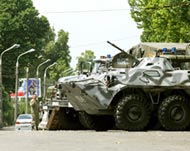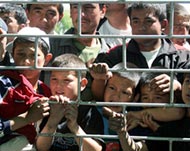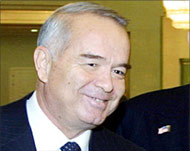Uzbek violence spreads as toll rises
Shooting has continued in eastern Uzbekistan where a bloody police crackdown on demonstrators has left up to 700 people dead.

Sporadic gunfire was heard on Monday in Andijan where an uprising over the past two days sparked a crackdown by security forces that left up to 500 people dead. A human rights group reported that clashes in another town killed an additional 200 people.
According to local observers, about 1000 refugees had fled into neighbouring Kyrgyzstan, and hundreds more were waiting to cross the border.
Saidjahon Zaynabitdinov, head of the local Appeal human rights advocacy group, said on Monday that government troops had killed about 200 demonstrators on Saturday in Pakhtabad, about 30km northeast of Andijan.
There was no independent confirmation of his claim.
Tense
Residents said government troops were fighting armed men in Bogishonol, an outlying district of the Andijan, but the claim could not be confirmed officially.
 |
|
There were ongoing clashes in |
Local reports said the town had been flooded with plainclothed policemen and there might have been some incidences of so-called friendly fire.
One observer told Aljazeera.net the governor of the province had promised to fire the majority of the police officials involved in the alleged shooting of demonstrators.
However, the observer said the authorities might not be able to contain the situation.
“This could be the start of something bigger, the sentiment is so high it will be hard to contain this unless the government carries out some reform,” the observer said on the condition of anonymity.
Genocide
Alexei Volosevich, an Andijan correspondent for the Fergana.ru website, said witnesses told him armed men had fired at police from the attics of apartment buildings near the city prison, and that police eventually had killed the assailants. There was no word about police casualties.
 |
|
Observers said hundreds were |
Troops and armoured personnel carriers formed a tight circle around the city centre, where the local administration building – at the centre of Friday’s violence – was on fire late on Sunday. Piles of sandbags used as defences in the fighting dotted the streets.
Men were digging what appeared to be a large common grave at a local cemetery under the watch of many Uzbek security service agents.
“It is sheer genocide against the people,” Zaynabitdinov said. “The people now are more afraid of government troops than of any so-called militants.”
Access restricted
The spreading unrest in a region bordering Kyrgyzstan – the worst since Uzbekistan gained independence from the Soviet Union in 1991 – also left 11 people dead in clashes on Sunday in a third town and sparked a rampage by residents in a fourth town on Saturday, witnesses said.
 |
|
Islam Karimov has blamed |
The government of President Islam Karimov has denied opening fire on demonstrators as witnesses have claimed, but the authoritarian government has sought to restrict access for reporters in the affected areas.
Karimov has blamed Islamic extremists for the violence.
Zaynabitdinov reiterated the protesters’ contention that they were not aiming to overthrow the government, but simply wanted to air their grievances.
“The demonstrators did not have any claims to power. It was just an outpouring of people’s feelings. People were driven out into the streets,” he said.
‘No terrorists here’
The violence puts the United States in a difficult position because it relies on Karimov’s government for an air base in the country and anti-terrorism support. So far, US authorities have only called on both sides to work out their differences peacefully.
In Andijan on Sunday, about 500 bodies were laid out in rows at the city’s School No 15, according to a respected doctor in the town, seeming to corroborate witness accounts of hundreds killed in the fighting.
The doctor, who spoke by telephone on condition she is not to be named, also said about 2000 people were wounded. The doctor is widely regarded as knowledgeable about local affairs.
In a separate clash in the border town of Teshiktosh on Sunday, eight government soldiers and three civilians were killed and hundreds of Uzbeks fled into neighbouring Kyrgyzstan, witnesses said.
In another border community, Korasuv, an estimated 5000 people went on a rampage on Saturday and forced authorities to restore a bridge across a river that marks the border with Kyrgyzstan. Local residents saw the government’s closing of the bridge more than two years ago as a move to deny them access to the better economy and more open politics of Kyrgyzstan.
“It was a popular uprising. There were no terrorists here, just ordinary people,” said Furkat Yuldashev, 32, as he stood with other townspeople near the bridge.